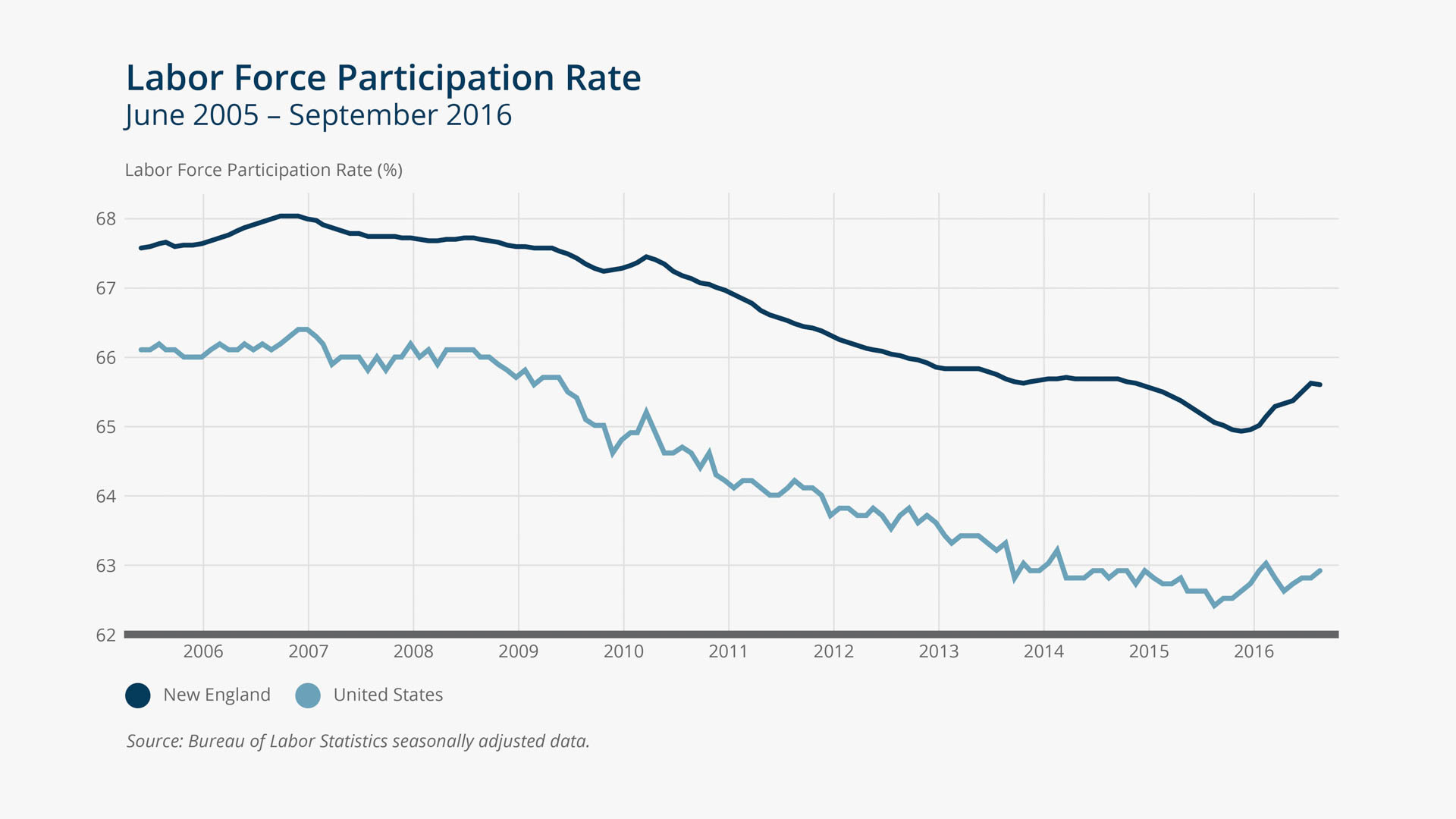2016 Series • No. 2016–2
Current Policy Perspectives
Labor Force Participation in New England vs. the United States, 2007–2015: Why Was the Regional Decline More Moderate? 
A number of papers have tried to make sense of the declines in U.S. labor force participation in recent years and to estimate the extent to which the currently depressed participation rate reflects cyclical rather than structural factors. Different methods yield different conclusions, but the most recent evidence (Aaronson et al. 2014) suggests that structural factors—the most important among these being population aging—explain a significant or even a dominant share of the net declines in participation since 2007.
In the New England region, the labor force participation rate has also fallen significantly since before the Great Recession. New England's August 2016 participation rate fell short of its own pre-recession peak value (from November 2006) by 2.4 percentage points, and the peak-to-trough decline for the region was a full 3 percentage points. (New England's trough occurred in October 2015.) These data indicate that the region's participation rate declined by a smaller margin than the nation's since 2007. As a result, the positive gap between New England's participation rate and the U.S. rate, a gap observed at least as far back as the mid-1970s, increased from an average of 1.8 percentage points in 2007 to an average of 2.6 percentage points in 2015. This paper seeks to identify the main forces that contributed to the recent declines in labor force participation in New England and the forces that moderated recent declines relative to the national trend. This exercise contributes to an assessment of the outlook for participation in the region moving forward.

 Key Findings
Key Findings
- Similar to previous findings pertaining to the United States as a whole, the single largest factor in the recent decline in labor force participation in New England was the shifting age composition of the region's population. In particular, the share of New England residents at or above retirement age (65 and over) increased by a considerable margin, while the share of residents of prime working ages (25 to 54) decreased, and these demographic trends were more pronounced in the region than in the nation as a whole between 2007 and 2015.
- Despite the fact that demographic changes should have imposed a larger drag on labor force participation in the region than in the nation in recent years, this larger drag was more than offset by beneficial cohort effects in the region. In particular, the participation rate among those ages 65 and over increased more sharply in New England than in the United States since 2007—a difference that was concentrated among senior citizens with at least some college education—and the participation rate among prime-age workers—and especially prime-age women—decreased less sharply in the region than in the nation. Together, these advantageous trends can more than account for the lesser decline in labor force participation in the region compared with the United States between 2007 and 2015.

 Exhibits
Exhibits


 Implications
Implications
The underlying causes of these regional advantages are hard to pinpoint. Obvious factors, such as differences in underlying educational composition cannot alone explain the differing trends between the region and the United States. In addition, neither migration patterns for the region nor changes in disability insurance rates help to explain the region's smaller decline in labor force participation. Declining average age among the region's college-educated seniors helps to explain the region's relatively large increase in participation by this group, but additional evidence shows that participation rates among college-educated seniors increased by a larger margin in New England than in the United States even among those within the narrow age range of 66-to-70 years.
The stronger cohort effects within the region suggest that, for selected demographic groups, characteristics of the regional population are more favorable for labor force participation than the characteristics of the national population on average. Alternatively, factors inherent in the regional economy—rather than necessarily inherent in its citizens—might encourage greater labor force participation among those with at least some college education. Among these individuals, the region's relatively low unemployment rate represents a cyclical factor that may have boosted participation in the region relative to the United States, especially in the past two years.

 Abstract
Abstract
This paper identifies the main forces that contributed to the decline in labor force participation in New England between 2007 and 2015, as well as the forces that moderated the region's decline relative to that of the nation. This exercise contributes to an assessment of the outlook for participation in New England moving forward. Similar to previous findings pertaining to the United States as a whole, the single largest factor in the recent decline in labor force participation in New England was the shifting age composition of the region's population. In particular, the share of New England residents at or above retirement age (65 and over) increased by a considerable margin, while the share of residents of prime working ages (25 to 54)decreased, and these demographic trends were more pronounced in the region than in the nation as a whole between 2007 and 2015. Partly offsetting the region's demographic disadvantages, the participation rate among those ages 65 and over increased more sharply in New England than in the United States since 2007, while the participation rate among prime-age workers decreased less sharply in the region than in the nation. Together, these advantages can more than account for the lesser decline in labor force participation in the region compared with the United States between 2007 and 2015.



